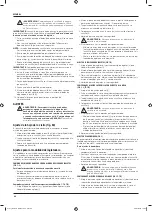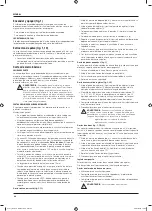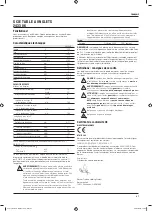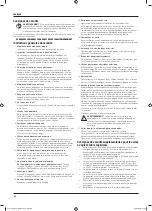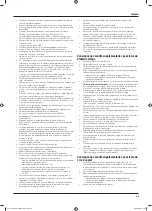
34
ENGLISH
• The minimum length of offcut material is 10 mm.
• When cutting workpieces longer than the table width, make sure that
the workpiece is stable over its full length. Support the protruding parts
of the workpiece as necessary, e.g., using the optional workpiece
extension.
• When cutting UPVC sections, a supporting piece made out of timber
with a complementary profile should be placed beneath the material
being cut to provide the correct level of support.
Straight Cross Cut (fig. 1, 11)
1. Loosen the locking knobs (bb, e) and move the top table to its highest
position. Lock both knobs.
2. Loosen the mitre knob (m) and depress the mitre latch (n) to release the
mitre arm (l).
3. Engage the mitre latch at the 0˚ position and tighten the mitre knob.
4. Place the wood to be cut against the fence (h, p).
5. Take hold of the operating handle (b) and depress the head lock-up
release lever (c) to release the head.
6. Switch the machine on and allow the saw blade to reach full speed.
7. Depress the head to allow the blade to cut through the timber and enter
the plastic kerf plate (j).
8. After completing the cut, switch the machine off and wait for the saw
blade to come to a complete standstill before returning the head to its
upper rest position.
Cutting Small Pieces (fig. 1)
The upper part of the left side of the fence (p) can be adjusted to provide
maximum support when cutting small pieces.
1. Raise the saw head to it's highest position.
2. Loosen the left side fence clamping knob (u).
3. Adjust the left fence as close to the blade as possible.
4. Tighten the knob securely.
Mitre Cross-Cut (fig. 1, 12)
1. Loosen the mitre knob (m) and depress the mitre latch (n) to release the
mitre arm (l). Move the mitre arm left or right to the required angle.
2. The mitre latch will automatically locate at 10˚, 15˚, 22.5˚, 31.62˚ and 45˚
both left and right, and at 50˚ left and right. If any intermediate angle is
required, hold the head firmly and lock by tightening the mitre knob.
3. Always ensure that the mitre knob is locked tightly before cutting.
4. Proceed as for a straight cross-cut.
WARNING:
When mitring the end of a piece of wood with a
small off-cut, position the wood to ensure that the off-cut is to
the side of the blade with the greater angle to the fence:
left mitre, off-cut to the right
right mitre, off-cut to the left.
Bevel Cuts (fig. 1, 7D, 13)
Bevel angles can be set from 45˚ left to 0˚ right and can be cut with the mitre
arm set between zero and a maximum of 50˚ mitre position right or left.
1. Loosen the locking knobs (bb, e) and move the saw bench table to its
highest position. Lock both knobs.
2. Loosen the left-side fence clamping knob (u) and slide the upper part of
the left-side fence (p) to the left as far as it will go.
3. Loosen the bevel clamp handle (jj) and set the bevel as desired as
shown in figure 7D.
4. Tighten the bevel clamp handle (jj) firmly.
5. Proceed as for a straight cross-cut.
Compound Mitre
This cut is a combination of a mitre and a bevel cut.
Set the bevel angle and subsequently set the mitre angle.
SAWING IN THE SAW BENCH MODE
• Always use the riving knife.
• Always ensure that the riving knife and blade guard are correctly
aligned.
• Always ensure that the mitre saw is set and locked in 0° mitre.
WARNING:
Do not cut metal in this mode.
Ripping (fig. 14)
1. Set the bevel and mitre angles to 0˚.
2. Set the saw blade height by adjusting the saw bench table (refer to
Adjusting the Saw Bench Table
). The correct blade position is to have
the tips of three teeth above the top surface of the wood. Ensure that
the saw bench table is securely fixed at the chosen height.
3. Set the parallel fence to the required distance.
4. Hold the workpiece flat on the table and against the fence. Keep the
workpiece approx. 25 mm away from the saw blade.
5. Keep both hands away from the path of the saw blade.
6. Switch the machine on and allow the saw blade to reach full speed.
7. Slowly feed the workpiece underneath the upper blade guard, keeping
it firmly pressed against the fence. Allow the teeth to cut, and do not
force the workpiece through the saw blade. The saw blade speed
should be kept constant.
8. Remember to use the push stick (aa) when close to the blade.
9. After completing the cut, switch the machine off, allow the saw blade to
stop and remove the workpiece.
WARNING:
• Never push or hold the free or cut-off side of the workpiece.
• Always use a push stick when ripping small workpieces.
Transporting (fig. 1–3)
1. To transport the saw, lower the saw bench table and the saw head to
their lowest positions and push the lock-down pin (cc) into place.
2. Move the mitre arm (l) to the far right mitre angle, slide the left-side
fence (p) completely inward and lock the bevel clamp handle (jj) with
the saw head in its lowest position to make the tool as compact as
possible.
3. Always use the hand indentations (s) shown in figure 1 to transport the
saw.
WARNING:
Always transport the machine in saw bench mode
with the upper blade guard fitted. Never carry the machine by
the guard.
MAINTENANCE
Your Berner power tool has been designed to operate over a long
period of time with a minimum of maintenance. Continuous satisfactory
operation depends upon proper tool care and regular cleaning.
WARNING: To reduce the risk of injury, turn unit off and
disconnect machine from power source before installing
and removing accessories, before adjusting or changing
set-ups or when making repairs.
Be sure the switch is in the
OFF position. An accidental start-up can cause injury.
If the saw blade does not stop in less than 10 seconds after switching off,
have the machine serviced by an authorised Berner repair agent.
Cleaning
Before use, carefully check the upper blade guard, movable lower blade
guard, as well as the dust extraction port to determine that it will operate
properly. Ensure that chips, dust or port particles cannot lead to blockage of
one of the functions.
In case of workpiece fragments jammed between saw blade and guards,
disconnect the machine from the power supply and follow the instructions
27511_Berners Manual.indd Sec1:34
08/07/2015 14:32























